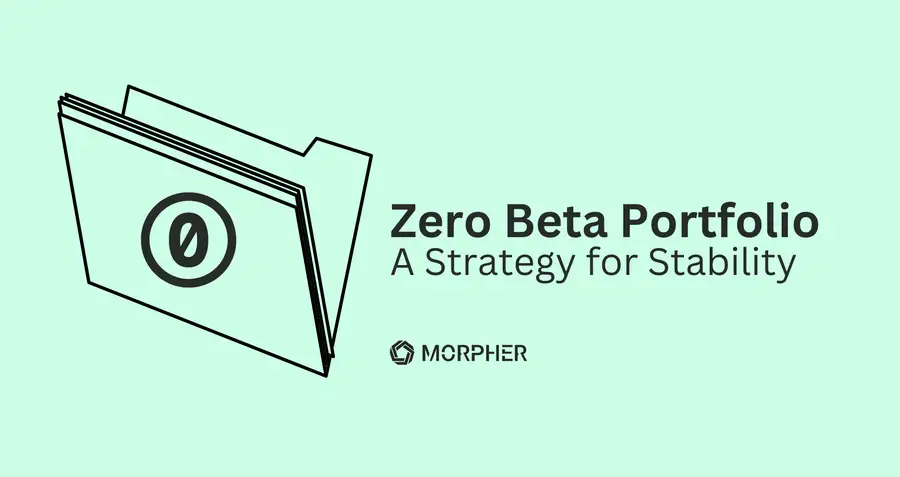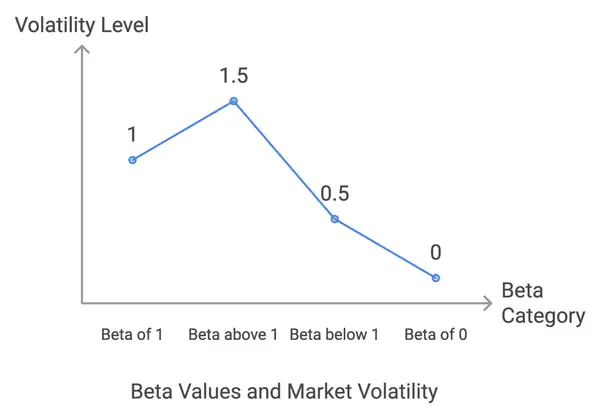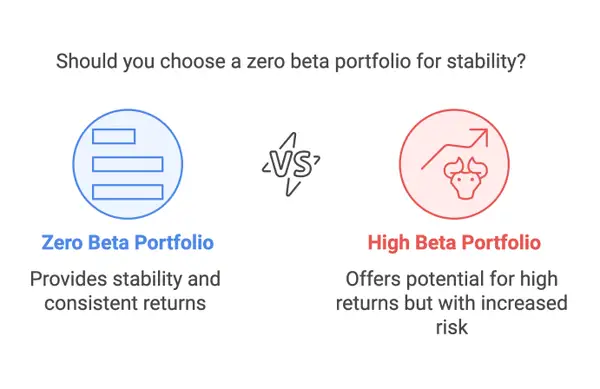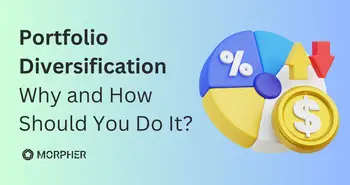Zero Beta Portfolio: A Strategy for Stability

Investing can be a rollercoaster ride; exciting when markets rise, but nerve wracking when they fall. For those who prefer a steadier approach, a zero beta portfolio can be a good option. It’s all about stability, insulating your investments from market swings while still aiming for consistent, reliable returns.
In this guide, we’ll explore what a zero beta portfolio is, how it works, and why it’s an appealing choice for risk-averse investors. More importantly, we’ll show how Morpher can simplify the process, offering the tools and features you need to create and maintain a portfolio that aligns with your financial goals.
What Is a Zero Beta Portfolio?
To understand a zero beta portfolio, we need to first understand “beta.” Beta measures how much an investment’s value fluctuates compared to the overall market:
- Beta of 1: The investment moves in sync with the market.
- Beta above 1: The investment is more volatile than the market.
- Beta below 1: The investment is less volatile than the market.
- Beta of 0: The investment has no correlation with market movements.
A zero beta portfolio is constructed to achieve this neutrality. Its value isn’t influenced by market ups and downs, making it a powerful strategy for reducing risk. Instead of being tied to market trends, it relies on low-correlation assets that provide stability and independence from broader economic shifts.

How Does It Work?
The concept is simple: combine assets that either have a beta close to zero or offset each other’s movements, so the portfolio as a whole remains uncorrelated with the market. Let’s break it down into actionable steps.
1. Low-Correlation Assets: Morpher’s Modern Approach
The foundation of a zero beta portfolio lies in selecting assets that don’t react to market volatility. Traditionally, this might include government bonds, cash equivalents, or alternative investments like real estate. However, Morpher offers a broader, more flexible toolkit:
- Fractional Commodities: Assets like gold and silver are classic safe havens, and on Morpher, you can invest in them fractionally with zero fees, ensuring they fit seamlessly into your strategy.
- Stable Cryptocurrencies: For a modern touch, consider low-volatility cryptocurrencies available on Morpher’s platform.
- Diversified Stocks: Even in equities, Morpher provides access to low-beta stocks from global markets, empowering you to build a portfolio that reflects your goals.
By eliminating trading fees and offering infinite liquidity, Morpher makes it easier to invest in these low correlation assets without worrying about traditional market constraints. Learn more about how zero commission works on Morpher.
2. Diversify Thoughtfully
Diversification is key to managing risk, and Morpher’s platform makes this process seamless. Instead of limiting you to traditional options, it opens up a range of assets to spread risk effectively:
- Global Markets: Trade stocks and commodities from around the world without high entry barriers.
- Fractional Investments: Allocate precise amounts to multiple assets, ensuring no single holding dominates your portfolio.
This level of flexibility means you can fine-tune your portfolio to balance stability with growth potential, all while minimising correlation to market trends. Check our guide on portfolio diversification for further details.
3. Monitor and Rebalance Easily
Building a zero beta portfolio is only half the battle. Over time, the beta of individual investments can shift, meaning regular rebalancing is essential. Here’s where Morpher excels:
- Zero Commissions: With no fees, you can adjust your portfolio as often as necessary without worrying about eating into your returns.
- Real-Time Data: Morpher provides live market insights to help you make informed decisions quickly.
- Ease of Use: Whether you’re reallocating into stable assets or experimenting with new opportunities, the platform ensures a hassle-free experience.
Rebalancing is no longer a chore—it’s a seamless process that keeps your portfolio aligned with your goals.
Why Choose a Zero Beta Portfolio?
A zero beta portfolio offers unique advantages for investors who value stability. Here’s why it stands out:
1. Insulation from Market Volatility
When markets are unpredictable, a zero beta portfolio provides a safe haven. Its value doesn’t depend on broader trends, making it ideal for times of economic uncertainty.
2. Consistent Returns
While you may not see dramatic growth, the reliability of steady returns can be just as rewarding. This makes the strategy especially appealing for retirees or those focused on wealth preservation.
3. Reduced Stress
Forget the anxiety of daily market fluctuations. A zero beta portfolio offers peace of mind, letting you focus on your financial goals without the noise of short-term volatility.
4. Portfolio Stability
For investors looking to build a long-term financial foundation, a zero beta portfolio provides a stable anchor, even as other parts of the market experience turbulence.

Challenges and Considerations
While the benefits are clear, it’s important to acknowledge the challenges:
- Lower Growth Potential: Avoiding market exposure means you miss out on potential gains during bull markets.
- Inflation Risk: Assets like bonds and cash equivalents may not keep pace with inflation, which could erode purchasing power over time.
- Effort Required: Constructing and maintaining a zero beta portfolio involves research and regular monitoring.
These limitations don’t diminish the value of the strategy—they simply highlight the importance of aligning it with your personal goals and using the right tools, like Morpher, to make it more effective.
Steps to Build a Zero Beta Portfolio with Morpher
Morpher simplifies the process of constructing a zero beta portfolio. Here’s how you can start:
1. Define Your Goals
Are you aiming to preserve wealth, generate income, or reduce risk? Morpher’s flexibility allows you to customise your strategy, whether you’re prioritising safety or exploring unique opportunities. You can start with creating your account in few minutes.
2. Select Low-Beta Investments
Morpher’s platform provides access to a diverse range of low-beta assets, including:
- Fractional shares of low-volatility stocks
- Commodities like gold and silver
- Stable cryptocurrencies for a modern edge
3. Diversify Your Holdings
Morpher empowers you to spread risk across global markets, alternative investments, and traditional asset classes. Fractional trading ensures you can allocate precise amounts to achieve balance.
4. Monitor and Rebalance Regularly
With zero trading fees and real-time data, Morpher makes it easy to rebalance your portfolio as needed. Whether you’re tweaking allocations or exploring new low-correlation assets, the platform ensures efficiency.
Why Morpher?
Morpher isn’t just a platform, it’s your partner in your investment journey. Here’s why it’s the perfect fit for building a zero beta portfolio:
- Zero Fees: Keep more of your returns by trading without commissions.
- Infinite Liquidity: Execute trades instantly, no matter the market conditions.
- Global Access: Explore a wide range of assets, from commodities to stocks, all in one place.
- Fractional Investing: Build a portfolio at any scale, tailored to your financial goals.
Morpher’s innovative approach takes the complexity out of investing, making it easier to create a zero beta portfolio that delivers stability and peace of mind.
Final Thoughts
A zero beta portfolio is a smart choice for investors looking to shield themselves from market volatility while achieving steady, reliable returns. With Morpher’s cutting-edge platform, constructing and managing such a portfolio has never been simpler. From fractional trading to zero fees, Morpher provides the tools you need to build a strategy that works for you.
Ready to take control of your financial future? Start building your zero beta portfolio today with Morpher and experience the benefits of modern, risk-free investing.
FAQ
Q: Can I achieve high returns with a zero beta portfolio?
A: While the primary objective of a zero beta portfolio is risk mitigation, it can still generate steady returns through income-producing assets. High returns, however, may not be the main focus of a zero beta portfolio.
Q: How do I choose assets for a zero beta portfolio?
A: When selecting assets for a zero beta portfolio, it's important to choose those that have little to no correlation with the broader market. Government bonds, high-quality corporate bonds, and certain alternative investments are often favored in zero beta portfolios.
Q: What are the limitations of zero beta portfolios?
A: One limitation of zero beta portfolios is the potential for missed opportunities during significant market upswings. Additionally, managing a zero beta portfolio requires careful monitoring and rebalancing to maintain its desired risk and return characteristics.
Ready to embrace the stability of a zero beta portfolio while unlocking the potential of diverse asset classes? Look no further than Morpher, the revolutionary trading platform that combines the benefits of zero fees, infinite liquidity, and blockchain technology. With Morpher, you can start investing in stocks, cryptocurrencies, forex, and more, with as little as $1.

Disclaimer: All investments involve risk, and the past performance of a security, industry, sector, market, financial product, trading strategy, or individual’s trading does not guarantee future results or returns. Investors are fully responsible for any investment decisions they make. Such decisions should be based solely on an evaluation of their financial circumstances, investment objectives, risk tolerance, and liquidity needs. This post does not constitute investment advice.

Painless trading for everyone
Hundreds of markets all in one place - Apple, Bitcoin, Gold, Watches, NFTs, Sneakers and so much more.

Painless trading for everyone
Hundreds of markets all in one place - Apple, Bitcoin, Gold, Watches, NFTs, Sneakers and so much more.









